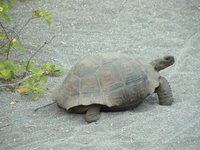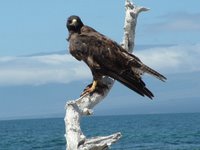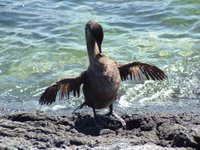You can't even imagine how relieved I was to learn that the trail today was going to be easy! In fact, we were told that it was going to be so easy that we could even wear flip flops! I decided to play it safe and wear the tevas, since I would probably kill myself in flip flops. After the wet landing on the beach, we dried our feet and started on the trail. This was a nice easy trail, consisting mostly of sand or small gravel. There were a few rocks interspersed, but most of it was relatively flat and smooth.
 Along the trail painted locusts hopped in and out amid the arid vegetation. One of the first trees we encountered was the Manzanillo tree (poison apple). The fruit of this tree resembles a small apple, but is highly toxic, resulting in stomach cramps if eaten. In addition, the sap in the leaves, can cause burning and blistering of the skin and eyes. We were warned that it was much worse than poison ivy.
Along the trail painted locusts hopped in and out amid the arid vegetation. One of the first trees we encountered was the Manzanillo tree (poison apple). The fruit of this tree resembles a small apple, but is highly toxic, resulting in stomach cramps if eaten. In addition, the sap in the leaves, can cause burning and blistering of the skin and eyes. We were warned that it was much worse than poison ivy.The first time we encountered this tree was actually at the Darwin Research Center. We had stopped to look at finches, and as we waited, Klaus got antsy and started playing with a nearby tree. When Mauricio saw that, he nearly lept across the trail and tackled Klaus, and then warned all of us not to touch that type of tree. We all laughed - Klaus had a way of getting into things!

There were also some nice yellow flowers along this path, which attracted quite a few carpenter bees. Mauricio also told us a story about galapagos cotton which grew there (and how the genes were being used for some type of hybrid cotton), and said something about how cherry tomatoes were a result of selective breeding between traditional tomatoes and a Galapagos tomato. He then went into a long speech about how the Galapagos was being exploited for the genes of some of the plants and animals, but Ecuador was not being compensated for this "gift" to the world. I'm not quite sure how accurate this information was.
 Not too far along the trail, we spotted a tortoise in the path. Woo hoo! I got to see a wild one! Now I don't feel so bad for missing the walk through Santa Cruz's highlands on Monday afternoon. It was a small one - probably only around 7-10 years old, but wild nonetheless. We probably spent a good 15 minutes standing and staring at it, although it didn't really do anything. As we approached it, it pulled its head into its shell about half way. After about 10 minutes, it poked its head back out, then wandered off into the vegetation on the side of the trail.
Not too far along the trail, we spotted a tortoise in the path. Woo hoo! I got to see a wild one! Now I don't feel so bad for missing the walk through Santa Cruz's highlands on Monday afternoon. It was a small one - probably only around 7-10 years old, but wild nonetheless. We probably spent a good 15 minutes standing and staring at it, although it didn't really do anything. As we approached it, it pulled its head into its shell about half way. After about 10 minutes, it poked its head back out, then wandered off into the vegetation on the side of the trail.A little further along the path, there were a few land iguanas. As
 we came around the bend in the trail, the amount of vegetation really decreased, and we saw a land iguana digging a burrow. We spent another 10 minutes or so watching it dig the burrow.
we came around the bend in the trail, the amount of vegetation really decreased, and we saw a land iguana digging a burrow. We spent another 10 minutes or so watching it dig the burrow. We walked further down the trail to a lagoon. We had hoped to see rays and sharks, but didn't have any luck in that regards.
We walked further down the trail to a lagoon. We had hoped to see rays and sharks, but didn't have any luck in that regards.We were able to see a few shore birds, but there wasn't much in that area other than mocking birds and finches. Each time somebody pulled out their water bottle for a drink the mocking birds would fly in closer, hoping to steal a drink. Unfortunately for them, none of us were willing to share.
Fernandina - Punta Espinosa
During lunch, the yacht headed to Punta Espinosa on Fernandina Island. We were told that this would be a dry landing, with a fairly easy trail. Because of the tide (and my clumsiness), we landed in the mangrove area rather than on the lava outcroppings. I was quite happy with this landing. There were nice concrete steps at the mangrove, and after chasing the sea lions off of
 them, the landing was very smooth!
them, the landing was very smooth!After a short walk out of the mangroves, we reached a sandy area surrounded by nesting grounds for marine iguanas. Mauricio stressed how important it was to stay within the boundaries of the trail markers, so we didn't accidentally step on or destroy and iguana eggs. From the numbers of iguanas that were there, I'm not sure it really would have been a problem if we had! There were thousands!
As we were starting to take pictures of the iguanas (and more sea lion pictures) we spotted a Galapagos Hawk further down the trail. Mauricio told us to see the hawk while it was still there. We were able to walk within about 10 feet of it (and a sea lion was peacefully slipping at the base of the tree where the hawk was perched).
On this island more than any, you could really see how multiple types of animals all shared the same living space. It was amazing to see iguanas, sea lions, crabs, hawks, and flightless
 cormorants all right next to each other -without anyone attacking anyone else! Absolutely incredible! Even more incredible was that humans were added to that mix!
cormorants all right next to each other -without anyone attacking anyone else! Absolutely incredible! Even more incredible was that humans were added to that mix!At this point, the trail turned from gravel to lava. This was the kind of lava I expected yesterday. There were big (mostly) flat slabs of lava, resembling walking over flagstone or across asphalt that barely survived expanding and contracting over a particularly rough winter. You had to watch where you were going so you didn't stub your toe, but you didn't have to worry about twisting an ankle. This is my kind of lava!
 The highlight of this island was the flightless cormorant. When I originally booked my cruise, I decided that I would rather go to Genovesa and see the red footed boobies, than go to Fernandina and see the flightless cormorants. While I still am disappointed that I didn't see any red footed boobies, I think the afternoon on Fernandina was one of the most spectacular visits during the cruise (at least so far). Words can't even describe how incredible it was to watch the cormorants dive into the water, then get back out and dry out. They went through this little ritual of drying their small atrophied wings. Watching them thermoregulate was also interesting. In their beak, they would have a little water bubble, and then they would pant. It was quite interesting.
The highlight of this island was the flightless cormorant. When I originally booked my cruise, I decided that I would rather go to Genovesa and see the red footed boobies, than go to Fernandina and see the flightless cormorants. While I still am disappointed that I didn't see any red footed boobies, I think the afternoon on Fernandina was one of the most spectacular visits during the cruise (at least so far). Words can't even describe how incredible it was to watch the cormorants dive into the water, then get back out and dry out. They went through this little ritual of drying their small atrophied wings. Watching them thermoregulate was also interesting. In their beak, they would have a little water bubble, and then they would pant. It was quite interesting.The island was absolutely beautiful. There was black lava, white sand, blue sky, green mangroves. There were lots of interesting animals, including frigate birds and blue footed boobies, hawks, crabs, cormorants, sea lions. There were interesting geologic formations, including some giant uplifted areas. There was even an old whale skeleton on the beach.
Once we were back on the ship, they immediately started the engine, since we were going to go up and around Isabela tonight. In doing so, we would cross the equator (twice). To celebrate the crossing of the equator, we all crammed into the bridge so we could see the GPS change from 0.00.00 degrees S to 00.00.00 degrees N. Woo hoo! We celebrated with a rum and tonic (blech!). Good thing we don't have to repeat it when we cross back in about 6 hours. Actually, we were treated to quite a nice sunset in the process and saw a few whale spouts and a few sunfish.
Each day, Mauricio ended the evening briefing by stating that "tomorrow will be even better than today".
This was the first night that I went to bed wondering how that would be possible!
No comments:
Post a Comment